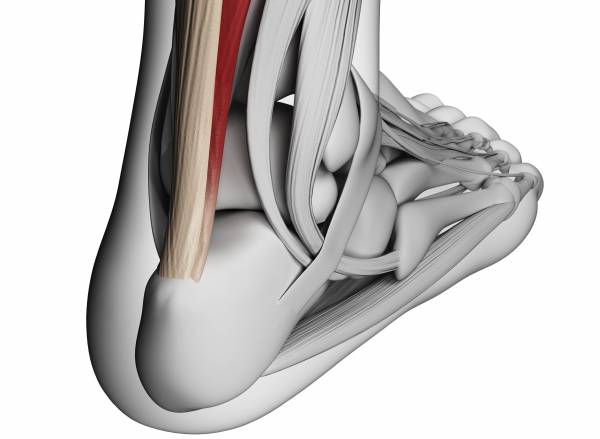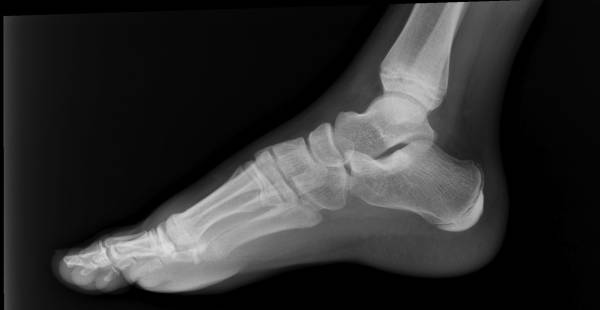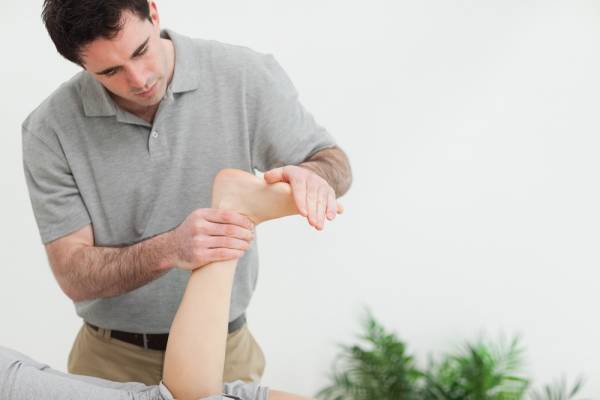<strong”>Achilles pain and Achilles injuries are common in youth athletes, especially those who participate in jumping and running sports, such as basketball, gymnastics, soccer, and track.
Achilles Anatomy
The Achilles tendon is a strong, fibrous band that attaches the calf muscle to the heel. The calf muscle is made up of two muscles, the soleus and the gastrocnemius. Together, these two muscles form the gastroc-soleus muscle group.
When the gastroc-soleus muscle group contracts, it pulls up on the Achilles tendon, causing the foot to point down. This powerful contraction helps us rise on our toes, which aids in walking, sprinting, jumping, and climbing.
RELATED: A 5-Step Approach to Training During Adolescent Growth Spurts
Several problems, ranging from mile to severe, can affect the Achilles tendon. Specifically, this article will address the role of the Achilles tendon in diagnosing and treating Sever’s disease (calcaneal apopyhsis), which can affect girls and boys during adolescent growth spurts (AGS).
What Is Sever’s Disease?
During AGS, and in specific reference to Sever’s disease, the heel bone grows faster than the Achilles tendon, resulting in an extremely tight Achilles tendon. Because the foot is one of the first parts of the body to grow to full size, and because the heel is not a very flexible area, it is especially susceptible to injury.
The Achilles tendon (also called the heel cord) is the strongest tendon that attaches to the growth plate in the heel. Over time, repeated stress (such as impact activities) on the tight Achilles tendon causes the tendon to pull on and damage the growth plate in the heel, resulting in swelling, tenderness, and pain.

There are several theories surrounding the cause of Sever’s disease. These range from a tight Achilles tendon, to micro stress fractures of the heel, to biomechanical mal-alignment, to trauma, to flat feet, and even to obesity. But the prevailing theory suggests the onset of Sever’s disease occurs when the child’s growth plate is at its weakest, while a tightened Achilles tendon pulls repeatedly on the growth plate, such as during AGS.
Symptoms and Diagnosis
Sever’s disease is a clinical diagnosis based on the youth’s presenting symptoms, rather than on diagnostic tests. While x-rays may be ordered in the process of diagnosing the disease, they are used primarily to rule out bone fractures or other bone abnormalities, rather than to confirm the disease.
Common Characteristics of Sever’s Disease:
- Posterior inferior heel pain
- Pain is usually absent when waking in the morning
- Increased pain with weight bearing, running, or jumping (or activity-related pain)
- Area often feels stiff or inflexible
- Youth may limp at the end of physical activity
- Tenderness at the insertion of the tendons
- Limited ankle dorsiflexion range that is secondary to tightness of the Achilles tendon
Activity or sport practices on hard surfaces can also contribute to pain, as well as poor quality shoes, worn out shoes, or the wrong shoes for the sport. Typically, the pain from this disease gradually resolves with rest.
RELATED: High Tops Are Ruining Your Kids’ Feet and Knees

Who Is at Risk for Sever’s Disease
Thedisease is most likely to occur during AGS. For girls, growth spurts usually occur between the ages of eight and thirteen. For boys, growth spurts usually occur between the ages of ten and fifteen.
“Because the foot is one of the first parts of the body to grow to full size, and because the heel is not a very flexible area, it is especially susceptible to injury.”
According to the Journal of the American Podiatric Medical Association, 2-16% of athlete boys aged seven to fifteen and athlete girls aged five to thirteen are diagnosed with Sever’s Disease on a yearly basis. Because the back of the heel hardens and becomes stronger when it finishes growing, Sever’s disease rarely occurs in older adolescents and teenagers.
RELATED: Kobe Bryant’s Achilles Injury: Why It Happened and What We Can Learn
How to Treat Sever’s Disease
The disease can be treated easily and is considered to be temporary, if treated promptly and correctly. If left untreated or if treated improperly, the disease can result in a permanent heel deformity, causing future shoe-fitting difficulties. Other long-term effects can include foot arch problems, potentially resulting in plantar fasciitis or heel spurs and tight calf musculature, which can lead to Achilles tendonitis.
“If a youth athlete complains of heel pain or Achilles tendon pain, seek medical advice for diagnosis, pain management, and a recovery plan.”
The American College of Foot and Ankle Surgeons recommends the following steps, once Sever’s disease has been diagnosed:
- Reduce or stop any activity that causes pain
- Temporary shoe inserts or custom orthotic devices may provide support for the heel
- Non-steroidal anti-inflammatory drugs (NSAIDs), such as ibuprofen, may help reduce the pain and inflammation
- Stretching and/or physical therapy may be used to promote healing
- In severe cases, a cast may be used to keep the foot and ankle immobilized during the healing process

Preventing Sever’s Disease
Because there are several theories as to the actual cause of the disease, there is no definitive answer on prevention. Experts agree, though, that youth athletes can help minimize the risk of Sever’s disease by maintaining good joint and muscle flexibility while engaging in sports or physical activities.
READ: Understanding and Caring for Your Feet
Additionally, foot arch problems, such as flat feet, should be identified and addressed by a medical professional prior to AGS. Finally, and most importantly, if a youth athlete complains of heel pain or Achilles tendon pain, seek medical advice for diagnosis, pain management, and a recovery plan. Most youth are able to return to their sport or activity as soon as their symptoms go away.
Receiving the initial diagnosis of Sever’s disease can be scary, and while the situation is painful, there is good news. If treated properly and quickly, Sever’s disease is temporary and will have no long-term effects on the athlete.
References
1. Miami Sports Medicine. “Achilles Tendon Injuries,” Accessed 30 November 2014.
2. American College of Foot and Ankle Surgeons (ACFAS), “Calcaneal Apophysitis (Sever’s Disease),” Accessed 30 November 2014.
3. New England Foot and Ankle. “Children’s Heel Pain – Sever’s Disease,” Accessed 30 November 2014.
4. Kid’s Health. “Sever’s Disease,” Accessed 30 November 2014.
5. McCarty, Chip, M.Ed., A.T. “Heel Pain in the Young Athlete,” Accessed 30 November 2014.
6. Miller, John. “Sever’s Disease,” Accessed 1 December 2014.
7. Scharfbillig, RW., Jones, S. Scutter, SD. “Sever’s Disease: What Does the Literature Really Tell Us?” Journal of the American Podiatric Medical Association. May/June 2008; 98:3:221-223. Reviewed by Dianne Mitchell, DPM. Accessed 30 November 2014.
8. Tassignon Bruno and Maarten Cnudde. “Sever’s disease,” Accessed 30 November 2014.
Photos 1, 2, and 4 courtesy of Shutterstock.
Photo 3 by Nevit Dilmen [CC-BY-SA-3.0} via Wikimedia Commons.






